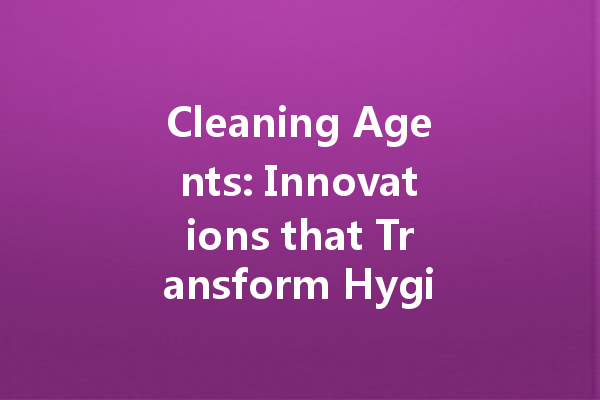In an increasingly health-conscious world, the demand for effective cleaning agents has surged, highlighting the need for innovations in this essential sector. This article explores the latest advancements in cleaning agents, examines their role in maintaining hygiene standards, and discusses the future of cleaning products.
The Evolution of Cleaning Agents
From Traditional to Modern Solutions
Cleaning agents have come a long way from the basic soap and water used centuries ago. As our understanding of chemistry and materials science has advanced, so too has our approach to cleanliness. The modern landscape is filled with specialized cleaning agents designed to tackle specific tasks, from disinfecting surfaces to eliminating stubborn stains. These agents boast improved efficacy and reduced environmental impact, making them essential in both residential and commercial settings.
The Move Towards Eco-Friendly Products
One notable trend in the cleaning industry is the shift toward eco-friendly products. Many manufacturers are responding to consumer demand for sustainability by developing cleaning agents that utilize biodegradable ingredients and minimal packaging. These innovations not only minimize environmental impact but also ensure safer use in homes, particularly for children and pets. This aligns perfectly with the growing awareness of eco-conscious living, making green cleaning agents increasingly popular.
Science Behind Effective Cleaning Agents
Understanding Surfactants and Their Role
At the heart of most cleaning agents lie surfactants—compounds that help reduce the surface tension of water, allowing it to spread and penetrate dirt and grime more effectively. By breaking down how dirt interacts with surfaces, surfactants enhance the overall cleaning power of products. Manufacturers experiment with different types of surfactants to improve the performance of their cleaning agents in various applications.
Innovations in Formulation
Research and development in the cleaning agent industry have led to the creation of formulations that are more efficient and effective. By incorporating advanced ingredients, such as enzymes or probiotics, manufacturers enhance the ability of their products to break down organic matter, grease, and grime. This not only saves users time but also reduces the need for harsh chemicals, aligning with the trend toward safer cleaning solutions.
Impact of Cleaning Agents on Public Health

Ensuring Hygiene Standards
In recent times, particularly with the COVID-19 pandemic, the role of cleaning agents in maintaining hygiene standards has never been more critical. Effective cleaning agents are essential for disinfecting surfaces in homes, offices, schools, and hospitals, helping to prevent the spread of viruses and bacteria. The innovation of disinfectants with fast-acting properties has accelerated the ability to maintain clean environments in high-traffic areas.
Addressing Allergens and Sensitivities
New cleaning agents are also being developed to cater to individuals with sensitivities or allergies. These products often feature non-toxic, hypoallergenic formulations that reduce common allergens found in traditional cleaning agents. As awareness of indoor air quality rises, many consumers are looking for cleaning products that can help improve their living spaces without compromising health.
The Future of Cleaning Agents
Trends Shaping Tomorrow’s Cleaning Products
As consumer preferences continue to evolve, the cleaning agent industry must adapt. Innovations such as smart cleaning products, which leverage technology for enhanced usability, are on the rise. For instance, some products now feature sensors that inform users when a surface needs cleaning or alert them to using the right cleaning agent for different materials.
The Role of Digital Transformation
Digital transformation also plays a crucial role in the cleaning industry. Enhanced supply chain management and user engagement through mobile apps allow consumers to connect with brands and learn about product efficacy more easily. This technology helps inform users about the best practices for utilizing cleaning agents, making cleaning more efficient and effective.
Conclusion
The innovations in cleaning agents have significantly transformed how we maintain hygiene standards in our daily lives. From eco-friendly formulations to scientifically-backed efficacy, the future holds exciting possibilities for further advancements in this essential industry. As cleaning agents evolve, they will not only continue to meet the demands of consumers but also contribute to a healthier and safer world for everyone.
